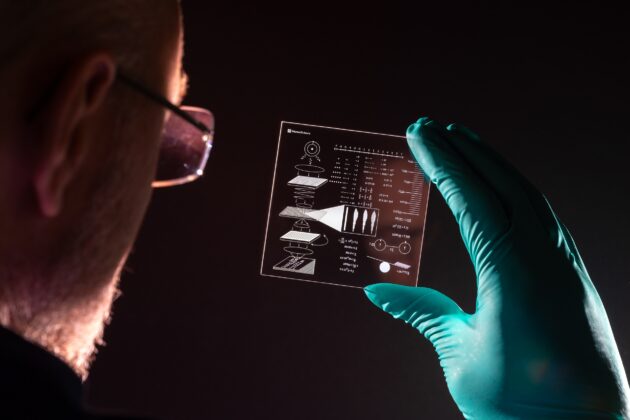Forty-seven years after NASA sent a “Golden Record” into deep space to document humanity’s view of the world, Microsoft’s Project Silica is teaming up with a citizen-science effort to lay the groundwork — or, more aptly, the glasswork — for doing something similar.
Golden Record 2.0, a project created by students, teachers and researchers affiliated with Avenues: The World School, is also getting an assist from artist Jon Lomberg, who was the design director for Golden Record 1.0.
The original Golden Record project involved preserving imagery and sounds from around the world on gold-plated phonograph records. Copies of the record were placed on NASA’s Voyager 1 and 2 probes and launched into space in 1977. The idea was that if space travelers came across the records in the distant future, they could decipher the recorded archive and learn what our world was like in the 20th century.
Golden Record 2.0’s organizers are going after the same idea, even though they’re still looking into how their archive would be packaged and launched.
Project Silica could play a role in the packaging. Richard Black, a manager at Microsoft Research’s Cambridge lab in Britain, has been leading an effort to store data inside thin platters of fused silica glass.
“It does that using ultrashort laser pulses that make a permanent, detectable and yet transparent modification to the glass crystal, so the data ends up as durable as the piece of glass itself,” Black explained in a Microsoft podcast called Collaborators.
Each coaster-sized platter could store several terabytes of data for many millennia, according to Microsoft. The data can be read out using a microscope, and decoded using machine-learning algorithms.
Black and his colleagues encoded a couple of test platters for Golden Record 2.0. They also created a glass-based instruction guide that could help anyone who came across the platters — either aliens or humans from the far future — figure out how to read them. “Obviously, humanity isn’t going to give up on microscopes, but if we can explain to extraterrestrials how they would go about reading a Silica platter, then it should be pretty obvious that we can explain to our human descendants how to do so,” Black said.
Meanwhile, the Golden Record 2.0 team is following the model used by Lomberg and the other creators of the original Golden Record, who digitized images as well as natural sounds, music and spoken words for their archive of humanity.
Back then, the internet was still in its infancy. Today, the 2.0 team is taking advantage of online tools to solicit multimedia contributions and get feedback on the media contributed by others.
PREVIOUSLY: How Microsoft put a ‘Superman’ movie on a piece of glass
“I like to think of it as sort of a time capsule of humanity that was designed to represent us — who we are as a species, what we love, why we love it, what we do, and our diversity, why we’re all different, why we do different things — to possible extraterrestrials,” said team member Dexter Greene, who’s beginning his freshman year as an engineering student at the University of Michigan.
Lomberg helped Greene and his teammates select and organize the content for the archive. He also filled them in on the story behind the original Golden Record, and the history and fundamentals of interstellar communication.
“People always ask me how I would do the Golden Record differently today,” Lomberg told GeekWire in an email. “I began this project at Avenues as a way of answering that question. Created by high schoolers and the most modern technology, this is a next-generation message to the stars.”
Over the decades, several other projects have styled themselves as successors to the Golden Record project. Lomberg himself was in charge of one of those efforts, which was called the OneEarth Message. More recently, the Arch Mission Foundation has had micro-miniaturized archives sent into space with the aid of partners ranging from SpaceX, Astrobotic and Intuitive Machines to Microsoft and the University of Washington.
The Golden Record 2.0 team hasn’t yet secured a ride to space. However, Greene said he and his teammates have been “talking a bit” with the team behind a similar effort called Humanity’s Message to the Stars (a.k.a. Message in a Bottle). That project is led by Jonathan Jiang, a researcher at NASA’s Jet Propulsion Laboratory.
Greene said commercial space ventures, including SpaceX, could provide additional options. “We’ve thought about all of that, and we’ve been reaching out to other space agencies,” he said.
Black said the effort is worth taking on even if Golden Record 2.0 never gets to the stars. “I think encouraging humanity to reflect on itself — where we are, the challenges ahead for us as a species here on planet Earth — you know, this is a good time to think those thoughts,” he said.
Greene agreed. “We’ve given a lot of thought to that,” he said. “Even if the record doesn’t reach extraterrestrials, is it worth it? … It’s so worth it, just for us to reflect on where we are, and how we can improve what we’ve done in the past, and what we can do in the future.”
